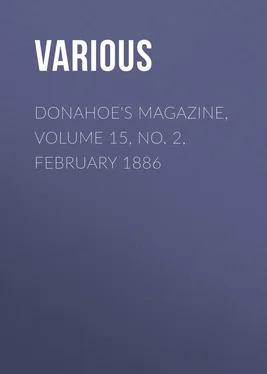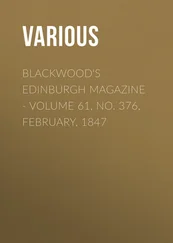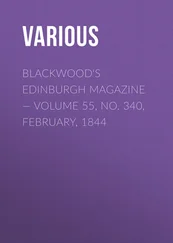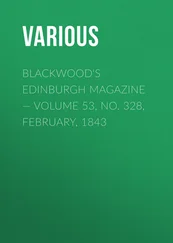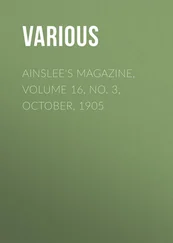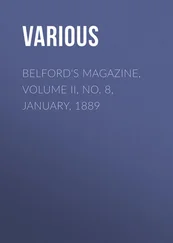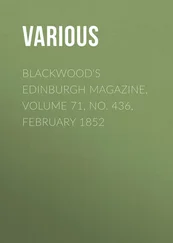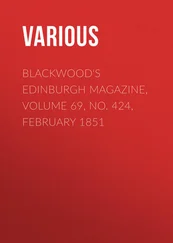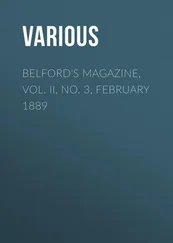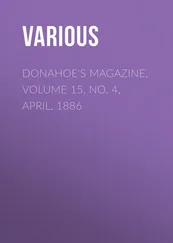Various - Donahoe's Magazine, Volume 15, No. 2, February 1886
Здесь есть возможность читать онлайн «Various - Donahoe's Magazine, Volume 15, No. 2, February 1886» — ознакомительный отрывок электронной книги совершенно бесплатно, а после прочтения отрывка купить полную версию. В некоторых случаях можно слушать аудио, скачать через торрент в формате fb2 и присутствует краткое содержание. Издательство: Иностранный паблик, Жанр: foreign_edu, periodic, на английском языке. Описание произведения, (предисловие) а так же отзывы посетителей доступны на портале библиотеки ЛибКат.
- Название:Donahoe's Magazine, Volume 15, No. 2, February 1886
- Автор:
- Издательство:Иностранный паблик
- Жанр:
- Год:неизвестен
- ISBN:нет данных
- Рейтинг книги:4 / 5. Голосов: 1
-
Избранное:Добавить в избранное
- Отзывы:
-
Ваша оценка:
- 80
- 1
- 2
- 3
- 4
- 5
Donahoe's Magazine, Volume 15, No. 2, February 1886: краткое содержание, описание и аннотация
Предлагаем к чтению аннотацию, описание, краткое содержание или предисловие (зависит от того, что написал сам автор книги «Donahoe's Magazine, Volume 15, No. 2, February 1886»). Если вы не нашли необходимую информацию о книге — напишите в комментариях, мы постараемся отыскать её.
Donahoe's Magazine, Volume 15, No. 2, February 1886 — читать онлайн ознакомительный отрывок
Ниже представлен текст книги, разбитый по страницам. Система сохранения места последней прочитанной страницы, позволяет с удобством читать онлайн бесплатно книгу «Donahoe's Magazine, Volume 15, No. 2, February 1886», без необходимости каждый раз заново искать на чём Вы остановились. Поставьте закладку, и сможете в любой момент перейти на страницу, на которой закончили чтение.
Интервал:
Закладка:
When twenty-seven years after he visited his native land, as the deputy of an infant nation and the saviour of the bards, on whom, but for his kindly intercession, the hand of infuriated justice had heavily fallen, his first visit was to Derry. It was probably during this visit that he founded that church on the other side of the Foyle, whose ivy-clad walls and gravelled area the reader of "Thackeray's Sketch Book" may remember; but few know that it was wantonly demolished by Dr. Weston (1467-1484), the only Englishman who ever held the See of Derry; and "who," adds Colgan, "began out of the ruins to build a palace for himself, which the avenging hand of God did not allow him to complete."
Columba's heart ever yearned to Derry. In one of his poems he tells us "how my boat would fly if its prow were turned to my Irish oak grove." And one day when "that grey eye, which ever turned to Erin," was gazing wistfully at the horizon, where Ireland ought to appear, his love for Derry found expression in a little poem, the English version of which I transcribed from Cardinal Moran's "Irish Saints."
"Were the tribute of all Alba mine,
From its centre to its border,
I would prefer the sight of one cell
In the middle of fair Derry.
"The reason I love Derry is
For its quietness, for its purity;
Crowded full of heaven's angels,
Is every leaf of the oaks of Derry.
"My Derry, my little oak grove,
My abode and my little cell,
O eternal God in heaven above,
Woe be to him who violates it."
With the same love that he himself had for his "little oak grove," he seems to have inspired the annalists of his race, for on turning over the pages of the Four Masters, the eye is arrested by such entries as,—
"1146, a violent tempest blew down sixty oaks in Derry-Columbkille."
"1178, a storm prostrated one hundred and twenty oaks in Derry-Columbkille."
These little tokens of reverence for the trees, which had been sanctified by his presence and love, show us how deep a root his memory had in the affections of the Donegal Franciscans, when they paused in their serious and compendious work to record every little accident that happened to his monastery. But, alas, all the protection that O'Donnell's clan might afford, all the fear that Columba's "Woe" might inspire, could not save his grove. Like many a similar one in Ireland, storms, and the destructive hand of man, have combined to blot it off the face of the landscape, and nothing now remains but the name.
The monastery, too, shared the same fate. Burned by the Danes in 812, 989, 997 and 1095, phœnix-like it rose again from its ashes, each time in greater beauty. The church, after one of these burnings, was rebuilt of stone; and from its charred and blackened appearance after the next burning, received the name of Dubh-Regles or Black Church of the Abbey—a name by which in the Annals the monastery itself is often called.
But Derry had other enemies than the Danes. In 1124 we find "Ardgar, Prince of Aileach, killed by the ecclesiastics of Doire-Columbkille in the defence of their church. His followers in revenge burned the town and churches." The then abbot was St. Gelasius, who, after presiding sixteen years over the monastery, which he had entered a novice in early youth, was, in 1137, raised to the Primatial See of Armagh; and dying in 1174, nearly closes the long calendar of Irish Saints. The first year of his abbacy (1121) had been marked by the death in the monastery of "Domwald Magloughlin Ardrigh of Erin, a generous prince, charitable to the poor and liberal to the rich, who, feeling his end approaching, had withdrawn thither,"—a fact which shows the great veneration in which this monastery was held.
The name of the next abbot, Flathbert O'Brolcan, or Bradley, is one of the brightest in the Annals of Derry. He was greatly distinguished for his sanctity and learning, but still more for his administrative abilities. As abbot of Derry he was present at the Synod of Kells in 1152. Six years after, at the Synod of Brightaig (near Trim, county Meath), a continuation or prorogation of that of Kells, Derry was created an Episcopal See and Flathbert appointed its first bishop. A much more honorable distinction was given him, when by the same synod, he was appointed "prefect general of all the abbeys of Ireland," an appointment which must probably be limited to the Columbian Abbeys, which were at the time very numerous. Some idea of the wealth and power of the Columbian order may be gathered from the records that the Masters have given us of Flathbert's visitations. "In 1150 he visited Tireoghain (Tyrone), and obtained a horse from every chieftain; a cow from every two biataghs; a cow from every three freeholders; a cow from every four villeins; and twenty cows from the king himself; a gold ring of five ounces, his horse and battle-dregs from the son of O'Lochlain, king of Ireland." "In 1153 he visited Down and Antrim and got a horse from every chieftain; a sheep from every hearth; a horse and five cows from O'Dunlevy, and an ounce of gold from his wife." And in 1161 he visited Ossory, and "in lieu of the tribute of seven score oxen due to him, accepted four hundred and twenty ounces of pure silver."
But though thus honored by the hierarchy and people, enemies were not wanting to him. In 1144 the monastery had been burned and hostile clouds were again gathering round it, when in 1163 Flathbert erected a cashel or series of earthen fortifications, which baffled for a time the enmity of the plunderer. A passing calm was thus assured him, of which he took advantage, in 1164, to commence the building of his Cathedral, called in Irish "Teampull-mor," a name which one of the city parishes still retains. But the times were troublous, and hardly was the Cathedral finished than we find in 1166 "O'More burning Derry as far as the church Dubh-Regles."
In 1175, on the death of their abbot the monks of Iona elected Flathbert; but he felt that the shadows of death were gathering round him, and he would not leave his own monastery of Derry. He died the same year, and "was buried in the monastery, leaving a great reputation for wisdom and liberality;" but before his death he had the pleasure of knowing that "1175, Donough O'Carolan perfected a treaty of friendship with the abbey and town, and gave to the abbey a betagh townland of Donoughmore and certain duties."
Читать дальшеИнтервал:
Закладка:
Похожие книги на «Donahoe's Magazine, Volume 15, No. 2, February 1886»
Представляем Вашему вниманию похожие книги на «Donahoe's Magazine, Volume 15, No. 2, February 1886» списком для выбора. Мы отобрали схожую по названию и смыслу литературу в надежде предоставить читателям больше вариантов отыскать новые, интересные, ещё непрочитанные произведения.
Обсуждение, отзывы о книге «Donahoe's Magazine, Volume 15, No. 2, February 1886» и просто собственные мнения читателей. Оставьте ваши комментарии, напишите, что Вы думаете о произведении, его смысле или главных героях. Укажите что конкретно понравилось, а что нет, и почему Вы так считаете.
